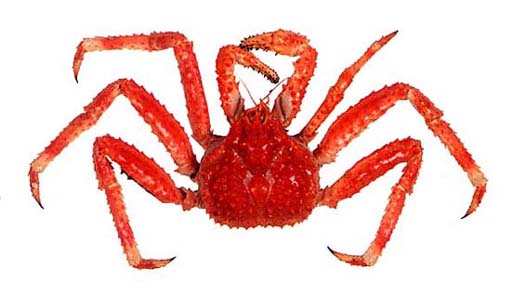タラバガニ科
- HOME
- デジタル図鑑
- パタゴニア海域の重要水族
- 節足動物門 甲殻綱 十脚目
- タラバガニ科
タラバガニ科(Lithodidae)

137 チリイバラガニ(Chiri-ibaragani)
Lithodes antarcticusJacquinot, 1852
Centolla del sur (Ch.)
特 徴:
甲幅15cmを超える大形種で,水産業上の重要種。甲,はさみ脚,歩脚とも一様に鋭い突起でおおわれている。突起に大小はあまりないが,甲幅5cm以下の小形個体では突起というよりもとげで,とくに甲幅3cm以下では著しく長く,別種のような印象を受ける。甲の輪郭は丸みをおびた三角形であるが,甲幅10cmを超える大形個体では鰓域が発達して四角形に近く,額部を含めて全体としては五角形に近い。胃域,心域,鰓域が適度に盛り上がり,胃域と鰓域を分ける部分と胃域と心域を分ける部分がへこむ。心域は後方が急に狭くなり,左右の鰓域との間の浅い溝は後方で互いに接する。額角の中央歯は下方に位置し,上方に湾曲して前方に突出する。それは眼窩外歯とほぼ等長である。額角の背面には2対の側棘があり,一般に斜め外方を向いている。肝域縁および鰓域縁に並ぶ突起は甲の背面のものと同形であるが,鰓域の前方および中央部の各1本ずつはやや大きい。はさみ脚は右大。歩脚は長く,前,後縁の突起は著しく鋭い。第2腹節は中央板と側板からなり,また,第3〜第5腹部の中央部に共通の膜質部をもつことは属としての特徴である。
分 布:
チリ南部,南緯42度付近から南米大陸南端を経てアルゼンチン,ブエノスアイレス沖まで。低潮帯から水深212m(今回の記録)。
備 考:
ベーリング海から日本沿岸の水深500〜600mに分布するイバラガニモドキに似ているが,やや小形で,甲および歩脚の突起の数が多い。成長とともに,とげから突起となることは両種とも同様である。
文 献:
Jacquinot and Lucas (1853); Haig (1955); Retamal (1981).
(武田正倫)
Material examined:
FSFL D1944 (1 young ♀-52°34′S, 59°17′W, 65 m deep; Dec. 16, 1969); B3056 (1♂-54°17′S, 61°30′W, 212 m deep; Dec. 20, 1969); V828, V868, V872, V874 (2♂♂, 1♀, 2 juv. ♂♂, 1 juv. ♀-51°59′S, 57°47′W, 104 m deep; Dec. 22, 1969); EM469 (1♂-37°02′S, 54°29′W, 135 m deep; Apr. 12, 1978); EM182 (1♂-53°59′S, 67°02′W, 51 m deep; May 15, 1978). Breadth of carapace, about 12.5 cm in largest male (V874) and about 15 cm in largest female (V828).
Description:
A large, commercially important species. Carapace, chelipeds and ambulatory legs uniformly covered with sharp conical tubercles of nearly equal size, but in the small individuals less than 3 cm in its breadth the carapace is armed with very long spines instead of tubercles; carapace roughly triangular with obtuse angles in its contour, but in the individuals more than 10 cm in carapace breadth the contour is rather pentagonal due to the development of branchial regions of both sides; gastric, cardiac and branchial regions moderately convex; cardiac region narrowing posteriorly and lateral furrows of both sides confluent posteriorly; hepatic and branchial margins fringed with conical tubercles. Median rostral tooth nearly as long as external orbital tooth, curving upward and extending forward, with 2 pairs of dorsolateral spines. Right cheliped larger than the left. Ambulatory legs long and armed with sharp tubercles on both margins and on upper surfaces. Second abdominal segment composed of a median and 2 lateral plates, and third to fifth segments united with chitinous membrane as one of generic features.
Distribution:
Known from Chilean coast at about 42° S through the Straits of Magellan northward to off Buenos Aires; lower littoral zone to 212 m deep.
Remarks:
The general shape of the carapace, chelipeds and ambulatory legs is similar to that of L. aequispina Benedict from the deep-water of the North Pacific, but the South American species is somewhat smaller and covered with denser tubercles. In both species the armature is variable with developing ages.
(Masatsune TAKEDA)

Distribution of Lithodes antarcticus in Patagonia.